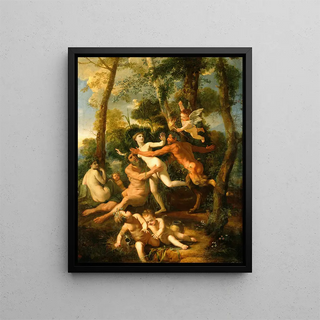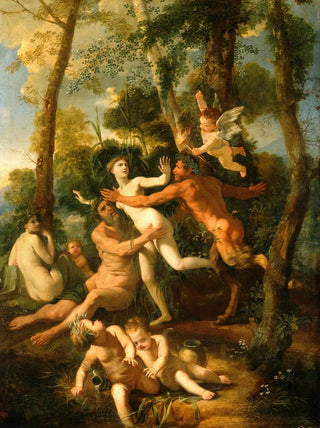Art print | Pan and Syrinx - Nicolas Poussin


View from behind

Frame (optional)
Pan and Syrinx Art print - Nicolas Poussin – Captivating Introduction
At the heart of Greek mythology, the artwork "Pan and Syrinx" by Nicolas Poussin stands as a poignant illustration of themes of love, transformation, and nature. This canvas, painted in the 17th century, recounts the tragic story of Syrinx, a nymph who, to escape the advances of the god Pan, transforms into a reed. Poussin, master of classicism, manages to capture not only the beauty of the scene but also the emotional intensity it conveys. Through this work, the viewer is invited to explore a world where desire and escape intertwine, revealing the complexity of relationships between mortals and deities.
Style and uniqueness of the work
Poussin's style is characterized by formal rigor and carefully orchestrated composition. "Pan and Syrinx" is no exception, displaying a visual harmony that evokes the serenity of ancient landscapes. The figures are arranged to create perfect balance, while warm, earthy colors reinforce the natural aspect of the scene. The artist uses light and shadow to emphasize the expressions of the characters, making their emotion almost palpable. Syrinx's nudity, both vulnerable and majestic, contrasts with Pan's imposing posture, highlighting the conflict between desire and reluctance. Furthermore, the lush vegetation surrounding the protagonists is a tribute to the beauty of nature, a theme dear to Poussin, who sees in it a reflection of human passions.
The artist and his influence
Nicolas Poussin, an emblematic figure of French classicism, established himself as one of the greatest masters of his time. Trained in Rome, he drew inspiration from Antiquity and the works of the great masters of the Renaissance. His rigorous approach to composition and his ability to convey complex emotions profoundly influenced the development of Western art. Poussin also played a key role in redefining landscape in art, transforming it into a narrative element in its own right. "Pan and Syrinx" perfectly illustrates this evolution, where the landscape becomes the silent witness

Matte finish

View from behind

Frame (optional)
Pan and Syrinx Art print - Nicolas Poussin – Captivating Introduction
At the heart of Greek mythology, the artwork "Pan and Syrinx" by Nicolas Poussin stands as a poignant illustration of themes of love, transformation, and nature. This canvas, painted in the 17th century, recounts the tragic story of Syrinx, a nymph who, to escape the advances of the god Pan, transforms into a reed. Poussin, master of classicism, manages to capture not only the beauty of the scene but also the emotional intensity it conveys. Through this work, the viewer is invited to explore a world where desire and escape intertwine, revealing the complexity of relationships between mortals and deities.
Style and uniqueness of the work
Poussin's style is characterized by formal rigor and carefully orchestrated composition. "Pan and Syrinx" is no exception, displaying a visual harmony that evokes the serenity of ancient landscapes. The figures are arranged to create perfect balance, while warm, earthy colors reinforce the natural aspect of the scene. The artist uses light and shadow to emphasize the expressions of the characters, making their emotion almost palpable. Syrinx's nudity, both vulnerable and majestic, contrasts with Pan's imposing posture, highlighting the conflict between desire and reluctance. Furthermore, the lush vegetation surrounding the protagonists is a tribute to the beauty of nature, a theme dear to Poussin, who sees in it a reflection of human passions.
The artist and his influence
Nicolas Poussin, an emblematic figure of French classicism, established himself as one of the greatest masters of his time. Trained in Rome, he drew inspiration from Antiquity and the works of the great masters of the Renaissance. His rigorous approach to composition and his ability to convey complex emotions profoundly influenced the development of Western art. Poussin also played a key role in redefining landscape in art, transforming it into a narrative element in its own right. "Pan and Syrinx" perfectly illustrates this evolution, where the landscape becomes the silent witness






